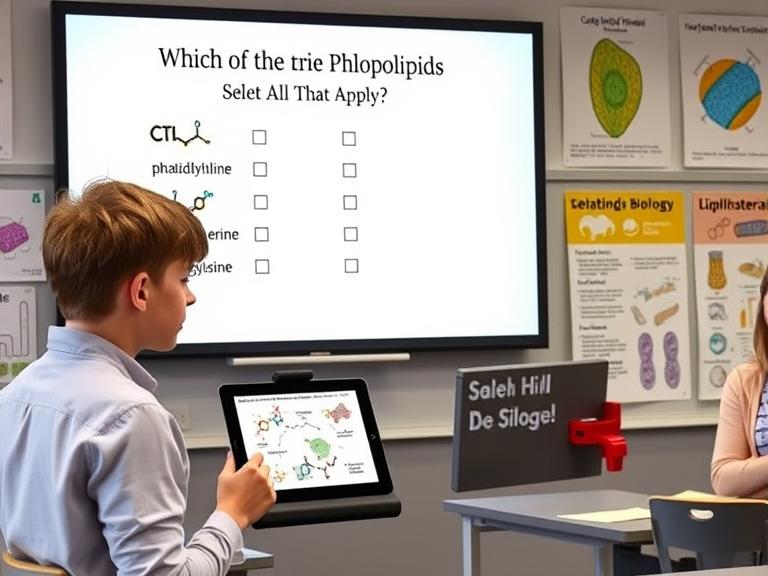Which of the Following Are Phospholipids Select All That Apply: Phospholipids are essential molecules that form the structural basis of cell membranes. They consist of a glycerol backbone, two fatty acid chains, and a phosphate-containing head group. This unique structure makes them amphipathic—having both water-loving (hydrophilic) and water-repelling (hydrophobic) properties.
If you’re wondering “Which of the following are phospholipids?”, this guide will:
- Explain what defines a phospholipid
- List common phospholipids found in nature
- Differentiate phospholipids from similar lipids
- Answer key FAQs about their structure and function
Table of Contents
What Makes a Molecule a Phospholipid?
For a lipid to qualify as a phospholipid, it must have:
- A phosphate group (usually attached to a polar head, like choline or serine).
- Two fatty acid tails (hydrophobic, non-polar).
- A glycerol or sphingosine backbone.
General Structure:
text
Polar Head (Phosphate + Organic Group)
|
Glycerol Backbone
|
|
Two Fatty Acid Tails (Hydrophobic)
Common Phospholipids (Select All That Apply)
Here are the major phospholipid classes found in biological systems:
1. Phosphatidylcholine (PC)
- Most abundant in animal cell membranes.
- Contains choline as the head group.
- Found in egg yolks and soybeans.
2. Phosphatidylethanolamine (PE)
- Common in bacterial membranes.
- Head group: ethanolamine.
- Plays a role in membrane fusion.
3. Phosphatidylserine (PS)
- Important for cell signaling and apoptosis.
- Head group: serine.
- Concentrated in brain cells.
4. Phosphatidylinositol (PI)
- Involved in cell signaling (e.g., insulin pathways).
- Head group: inositol.
- Precursor to secondary messengers.
5. Sphingomyelin
- Found in myelin sheaths (nerve insulation).
- Backbone: sphingosine (not glycerol).
- Contains phosphocholine head group.
6. Cardiolipin
- Present in mitochondrial membranes.
- Unique structure: two phosphatidyl groups linked.
- Critical for energy production.
What Is NOT a Phospholipid?
Some lipids are often confused with phospholipids but lack the defining phosphate group:
| Molecule | Why It’s Not a Phospholipid |
|---|---|
| Triglycerides | No phosphate; just glycerol + 3 fatty acids |
| Cholesterol | Steroid lipid; no phosphate or glycerol |
| Ceramides | Sphingosine-based but lack phosphate |
| Free fatty acids | Single hydrocarbon chains |
Functions of Phospholipids
Beyond forming cell membranes, phospholipids:
✔ Facilitate cell signaling (e.g., PI in hormone responses).
✔ Enable vesicle formation (transport within cells).
✔ Support lung function (pulmonary surfactant contains PC).
✔ Aid blood clotting (PS exposure triggers coagulation).
FAQs About Phospholipids
1. Are all phospholipids found in cell membranes?
Most are, but some (like platelet-activating factor) act as signaling molecules.
2. Why do phospholipids form bilayers?
Their amphipathic nature drives them to shield hydrophobic tails from water.
3. Can humans synthesize phospholipids?
Yes, primarily in the liver, but some (like linoleic acid) must come from diet.
4. Which phospholipid is most common in the brain?
Phosphatidylserine (PS) and sphingomyelin are abundant in neural tissue.
5. Do plants have phospholipids?
Yes—phosphatidylcholine is major in plant membranes.
6. How are phospholipids different from glycolipids?
Glycolipids have sugar groups instead of phosphate heads.
Conclusion: Identifying Phospholipids
When asked “Which of the following are phospholipids?”, look for:
✅ Phosphate-containing head groups
✅ Glycerol/sphingosine backbone
✅ Two fatty acid tails
Key examples include PC, PE, PS, PI, sphingomyelin, and cardiolipin. Understanding these molecules is crucial for cell biology and biochemistry studies.
Test Your Knowledge:
Which of these is a phospholipid?
A) Cholesterol
B) Phosphatidylcholine
C) Triglyceride
(Answer: B)

